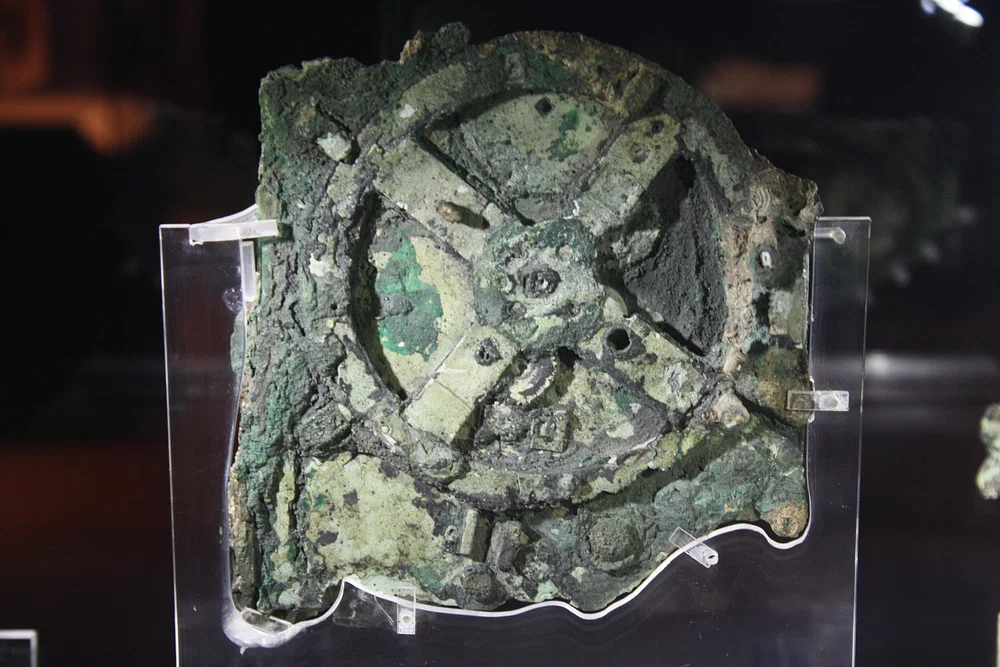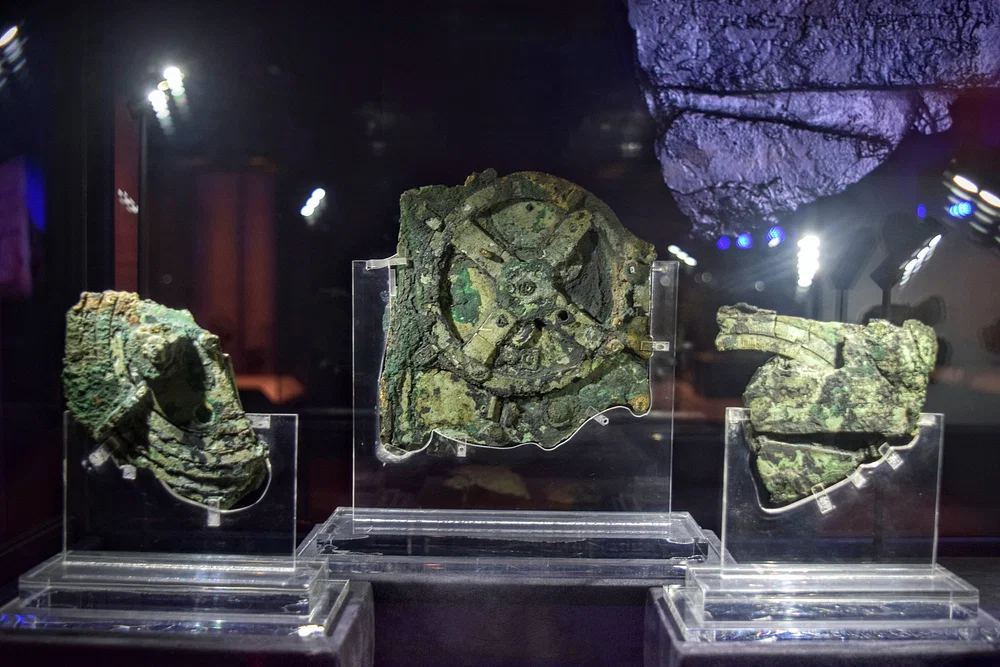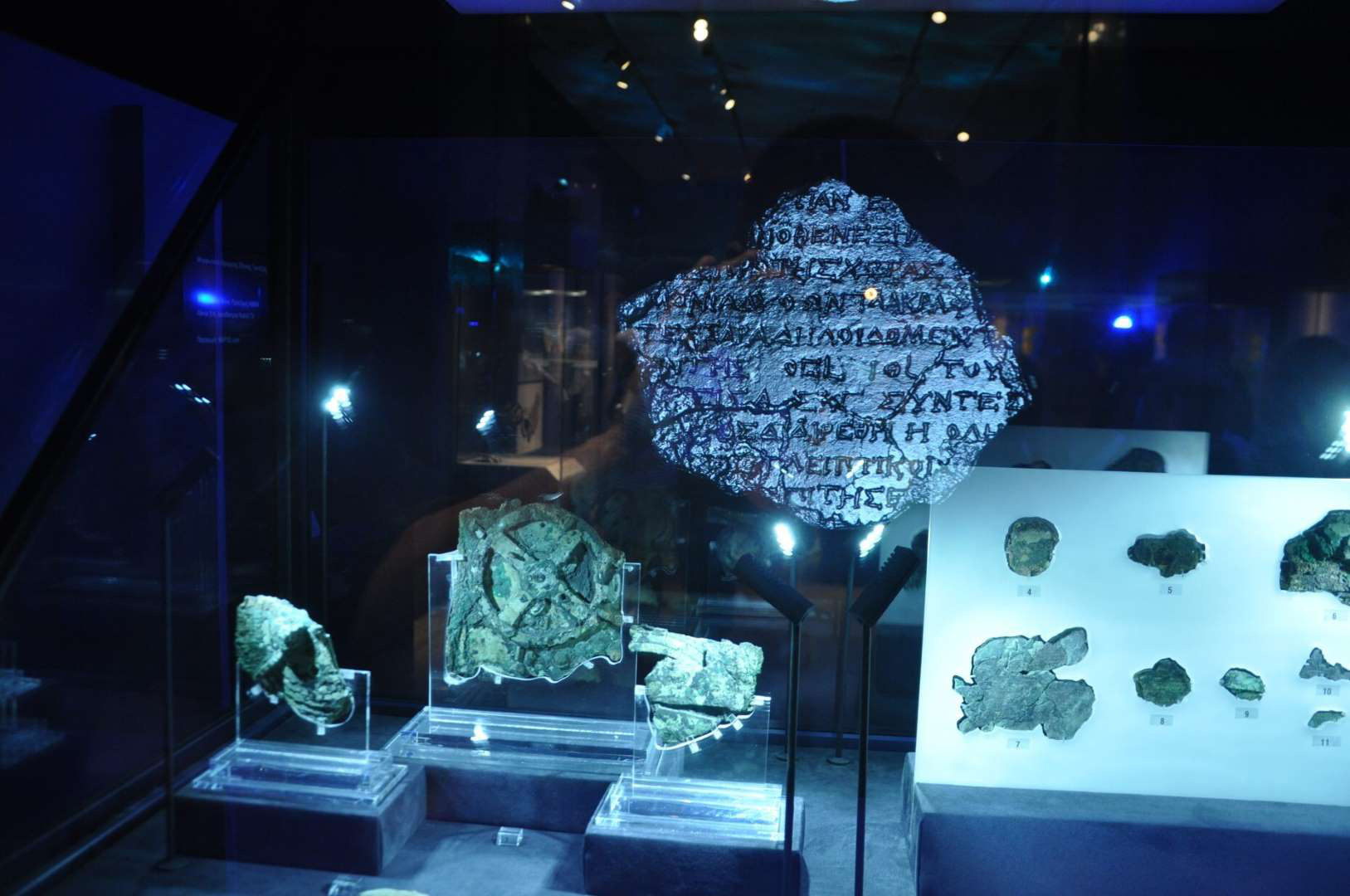The Antikythera Mechanism, also known as the Antikythera Device, is dated to the late 2nd century/early 1st century BCE (roughly 205-60 BCE) and is understood as the world’s first analog computer. It was created to accurately calculate the position of the sun, moon, and planets. The mechanism was found in 1901 off the Greek island of Antikythera, giving it its name.

Discovery and Initial Analysis
The mechanism, thought to have originally been over a foot tall and housed in a wooden box, was discovered as a corroded lump of metal amidst the wreckage of an ancient merchant vessel that also carried statuary, amphorae, and other goods. There were so many artifacts retrieved from the wreckage that the oddly formed and unidentified lump went unnoticed until 1902 when it was seen by the Greek archaeologist Valerios Stais in a workroom at the National Archaeological Museum in Athens. Work on deciphering the meaning and purpose of the device began soon after and continues to the present day. The device was recognized as some sort of calculator as early as 1905, perhaps a different sort of astrolabe, but significant progress in understanding its purpose only began in the late 20th century.
Fragmentation and Reconstruction
The machine first broke into three pieces after its removal from the sea and then steadily fragmented into 82 smaller parts over the years as it was handled by different researchers, making the puzzle harder to solve. Freeth and his team built a reconstruction of the device in 2021, and today, after over 2000 years, the first analog computer in the world is again functional.

Foundations of Greek Astronomy
The principles of ancient Greek astronomy were derived from the earlier systems of the Babylonians and Egyptians, as noted by scholar Thomas L. Heath:
As early as the second millennium BC, the Babylonians recognized the zodiac as the circle in which the planets move. They divided it into signs of 30 degrees each and, when we are told by Pliny that Cleostratus of Tenedos, who belongs probably to the second half of the sixth century BC, “recognized the signs in it”, it is a fair inference that Cleostratus imported from Babylon into Greece the knowledge of the zodiac and the constellations in it, and perhaps of some other constellations. (xvi)
Cleostratus (l. c. 520 to c. 432 BCE) may have introduced the zodiac to Greece, but Greek astronomy was first developed by Thales of Miletus (l. c. 585 BCE) who had studied at Babylon and possibly traveled in Egypt. Thales, among his other accomplishments, is considered the first astronomer of ancient Greece for accurately predicting the solar eclipse of 28 May 585 BCE. It has also been suggested that the innovations attributed to Cleostratus of Tenedos may have been wrongly credited to him by Pliny the Elder, and actually belong to Thales.
Ionians and Greek Science
Thales’ successors in the Ionian school of Greek philosophy (so-called because of its origin in Ionia), Anaximander (l. c. 610 to c. 546 BCE) and Anaximenes (l.c. 546 BCE) rejected his claim that water was the First Cause of observable phenomena but seem to have built upon his astronomical work. Whether this is so, or what innovations they introduced, is unclear as none of Thales’ works have survived and he is only known through references by later writers.
These thinkers established the foundation for what would later be recognized as Greek science by rejecting supernatural explanations for causality and claiming that the universe was rational and knowable. Prior to the Ionians’ observations, the traditional understanding of the world, as created and maintained by the gods, was accepted as answering any question on where the world came from and how it functioned. The Ionians, and the Pre-Socratic philosophers who came after them, challenged this view.

The Ionians never denied the existence of the gods; they only challenged how those gods had been depicted by Homer and Hesiod (both of the 8th century BCE) as, essentially, immortal humans with superpowers who, like all humans, were prone to irrational outbursts and emotional responses to which observable phenomena – like the changing of the seasons – were attributed. To the Ionians, there was a much simpler explanation for why things happened as they did, and this was that the universe operated on a set of established laws that could be understood.
Pythagoras & Astronomy
Pythagoras (l. c. 571 to c. 497 BCE) is also considered the first Greek astronomer as he developed a mathematical system that explained planetary movement. Like Thales, none of the works of Pythagoras (if he wrote any) have survived but, based on fragments cited by later writers, he claimed that the First Cause of the universe was Number and that an understanding of mathematical principles was key to understanding how the universe worked.
Pythagoras influenced the works of Plato (l. 424/423-348/347 BCE) who then influenced his most famous student Aristotle (l. 384-322 BCE), tutor of Alexander the Great, who brought scholars, also influenced by Aristotle’s thought, on his campaign to conquer the Persian Achaemenid Empire, reintroducing the concept that had come from Babylon to Greece to their homeland in a more developed form. Aristotle’s views on astronomy, and virtually every other subject, shaped the discussion and development of various disciplines up through the European Middle Ages.

The later astronomers, including Aristarchus of Samos (l. c. 310 to c. 230 BCE), Eratosthenes of Cyrene (l. 276-195 BCE), Archimedes of Syracuse (l. c. 287 to c. 212 BCE), Hipparchus of Nicea (l. c. 190 to c. 120 BCE), and Claudius Ptolemy (l. 100-170 CE) were all, to greater or lesser degrees, influenced by Aristotelian thought, which was informed, in part, by Pythagorean Greek mathematics, which also allowed the famous mathematician Euclid (l. c. 300 BCE) to develop his systems.
The Antikythera Mechanism
These developments enabled the creation of the astrolabe, credited to the astronomer Apollonius of Perga (l. c. 240 to c. 190 BCE) and possibly refined by Hipparchus of Nicea. The astrolabe, a handheld device used to tell time, predict sunrise and sunset, and locate celestial objects, was probably created c. 225 BCE, 20 years earlier than the earliest date given to the Antikythera mechanism. It is possible that the astrolabe, in fact, inspired the later device, though this is speculative.
The most likely inventors of the device are Archimedes of Samos or Hipparchus of Nicea depending on which date one accepts for the Antikythera mechanism. The device is thought to have originally measured 34 centimeters (13 in) tall, regularly described as “about the size of a shoebox”, was made of bronze, and consisted of a front and back plate, a central plate as the mounting board for gear trains, a 223-tooth gear at the back, a 127-tooth gear on one side of the central plate, a 38-tooth gear on the other, a 58-tooth gear attached to that, and a total of 69 gears in all, housed in a wooden box with a crank on the side. By setting a date indicator on the front plate and turning this crank, the interlocking gears would engage and provide whatever astronomical information for that date. It is considered the first analog computer in the world because, at the simplest level, it processed continuously varying data.
In 2005, CT scans revealed inscriptions on the back plate which turned out to be a user manual. Scans of the front plate showed it was divided into five sections, each corresponding to the five planets then known – Mercury, Venus, Mars, Saturn, and Jupiter – which inspired Michael Wright, “former curator of mechanical engineering at London’s Science Museum” (Freeth, 6) in his work to decipher the purpose of the device in 1990. Wright x-rayed the mechanism and was able to determine how its three fragments originally fit together. The device was used to explain the cycles of the planets, which seemed to sometimes reverse their course, but it could also predict eclipses, star events, chart the phases of the moon, the heliacal rising and setting of certain constellations, the course of seasons and years, and the Olympiad cycle on which the celebration of the Olympic Games was based.
The device would have been impossible to create without trigonometry and, if Hipparchus of Nicea is acknowledged as the creator of that system, the mechanism would have to have been created either by him or after his time. It is possible, however, that Hipparchus only developed trigonometry, leaving the possibility open that the device was created earlier, possibly by Archimedes. Whoever created it, the concept required imagination coupled with mechanical, mathematical, and astronomical aptitude of the genius level. Once the purpose and technological sophistication of the device was understood, its existence amazed researchers, scholars, and historians who, until that time, held that this level of technology was not developed until the 14th century.
Discovery & Mystery
From the time the device was first recognized as an object of interest, however, it had intrigued the scholarly and scientific community. The ancient shipwreck, dated to c. 70-60 BCE, was discovered at a depth of 45 meters (148 ft) in 1900 off the shores of Antikythera island by Captain Dimitrios Kontos of Symi island and his crew of sponge divers. Kontos contacted the Greek government after one of his divers surfaced with a bronze arm from a statue, and the Hellenic Navy was engaged to help excavate the wreckage.
Initially, the ship was thought to have been carrying spoils looted by the Romans from various Greek cities, but it is now understood to have been a trade vessel carrying cargo from sellers to buyers. Among the many treasures brought up from the wreckage was “a mechanical object composed of wood and metal, about the shape and dimensions of a shoebox” (Jones, 2). According to an early anecdote, possibly apocryphal, the lump of metal was so unimpressive it was almost thrown back into the sea. Instead, it was taken to the National Archaeological Museum in Athens where it was described as “one slab with an inscription, whose letters, however, could not be copied” (Jones, 10). It was placed with other finds from the wreck in a storeroom until 18 May 1902 when it was seen by Valerios Stais, who noticed its interlocking gears and Greek letters through the corrosion. A few days later, the news broke that an ‘important discovery’ had been made at the Archaeological Museum, but, although the object was certainly now of greater interest than before, no one knew what it was.
Between 1905 and 2021, researchers, scholars, scientists, technicians, and others have worked to discover the purpose and function of the device, but early efforts failed because they lacked the necessary technology. Only with modern equipment could the inner recesses of the device be accessed and understood. Even though Freeth’s team seems to have successfully recovered and built a modern version of the mechanism, even he claims that, lacking certain key original parts, their analysis and conclusions may be incomplete.
Conclusion
Even so, the work of the Antikythera Research Team, if it has not completely reconstructed the device, has certainly greatly advanced understanding of its function and purpose. Based on the sophistication of the device, it is thought it was the final product of a series of prototypes, now lost, and that it was only one of many such mechanisms produced once the mechanics of constructing it had been mastered. It is possible, then, that there are many other similar devices in other shipwrecks or buried under modern cities awaiting discovery.




